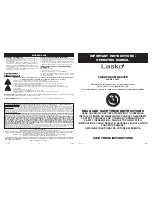
www.
hotwater .com 15
INSTALLING THE NEW WATER HEATER
WATER PIPING INSTALLATION
Note:
Water piping and vent piping occupy the space
above the water heater. Plan the water piping to ensure
it does not cause interference with the vent piping (see
“Venting”).
•
The system should be installed only with piping that is
suitable for potable (drinkable) water such as copper,
CPVC, or polybutylene. This water heater must not be
installed using iron piping or PVC water piping.
•
Use only pumps, valves, or
fi
ttings that are compatible
with potable water.
•
It is recommend that only full
fl
ow ball or gate valves
are used in water piping installations. The use of valves
that may cause excessive restriction to water
fl
ow is
not recommended.
•
Use only 95/5 tin-antimony or other equivalent solder.
Any lead based solder must not be used.
•
Piping that has been treated with chromates, boiler
seal, or other chemicals must not be used.
•
Chemicals that may contaminate the potable water
supply must not be added to the piping system.
Piping,
fi
ttings, and valves should be installed according
to the installation drawing (see Figure 9). If the indoor
installation area is subject to freezing temperatures, the
water piping must be protected by insulation.
Important:
Heat must not be applied to the water
fi
ttings on
the heater as they may contain nonmetallic parts. If solder
connections are used, solder the pipe to the adapter before
attaching the adapter to the hot and cold water
fi
ttings.
Important:
Always use a good grade of joint compound
and be certain that all
fi
ttings are drawn up tight.
1. Install the water piping and
fi
ttings as shown in Figure
9. Connect the cold water supply (3/4” NPT) to the cold
water inlet
fi
tting. Connect the hot water supply (3/4”
NPT) to the hot water outlet
fi
tting.
Important:
These models may contain energy saving heat
traps to minimize the migration of heat to the pipes. Do
not remove the inserts within the heat traps.
2. The installation of unions in both the hot and cold water
supply lines is recommended for ease of removing the
water heater for service or replacement.
3. If installing the water heater in a closed water system,
install an expansion tank in the cold water line as
speci
fi
ed under “Closed Water Systems” and “Thermal
Expansion”.
4. Install a shut-off valve in the cold water inlet line. It
should be located close to the water heater and be
easily accessible. Know the location of this valve and
how to shut off the water to the heater.
5. After piping has been properly connected to the water
heater, remove the aerator at the nearest hot water
faucet. Open the hot water faucet and allow the tank
to completely
fi
ll with water. To purge the lines of
any excess air, keep the hot water faucet open for
3 minutes after a constant
fl
ow of water is obtained.
Close the faucet, reinstall the aerator and check all
connections for leaks. Repair as needed.
METAL
DRAIN
PAN
FLOOR
DRAIN
HOT WATER
OUTLET
COLD
WATER
INLET
UNION
UNION
3/4” SWEAT
FITTING
3/4” SWEAT
FITTING
TEMPERATURE-
PRESSURE
RELIEF VALVE
DISCHARGE PIPE
(DO NOT CAP
OR PLUG)
6 ” MAX.
AIR GAP
DRAIN
VALVE
SHUT-OFF
VALVE
SOME
COMPONENTS
NOT SHOWN
FOR CLARITY.
EXPANSION
TANK
Figure 9
Figure 9 shows typical attachment of water piping to the
water heater. The water heater is equipped with 3/4” NPT
water connections.
CLOSED WATER SYSTEMS
Water supply systems may, because of code requirements
or such conditions as high line pressure, among others,
have installed devices such as pressure-reducing valves,
check valves, and back
fl
ow preventers. Devices such
as these cause the water system to be a closed system.
THERMAL EXPANSION
As water is heated, it expands (thermal expansion). In a
closed system, the volume of water will increase when
heated. As the volume of water increases, there will be a
corresponding increase in water pressure due to thermal
expansion. Thermal expansion can cause premature tank
failure (leakage). This type of failure is not covered under
the limited warranty. Thermal expansion can also cause
intermittent temperature-pressure relief valve operation:
water discharged from the valve due to excessive pressure
build up. The temperature-pressure relief valve is not
intended for the constant relief of thermal expansion. This
condition is not covered under the limited warranty.
















































